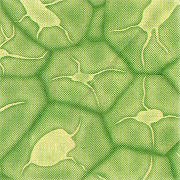Homeostasis
Sclerides
Sclereids typically are short cells with thick secondary walls, strongly lignified, and provided with numerous simple pits. Some sclereids have relatively thin secondary walls, however, and may be difficult to distinguish from …
Fibers
Fibers typically are long, spindle-shaped cells, with more or less thick secondary walls, and they usually occur in strands. Such strands constitute the “fibers” of commerce. The process of retting (technical form of …
Sclerenchyma

The term sclerenchyma refers to a tissue composed of cells with secondary walls, often lignifi ed, whose principal function is mechanical or support. These cells are supposed to enable plant organs to …
Parenchyma
The term parenchyma refers to a tissue composed of living cells variable in their morphology and physiology, but generally having thin walls and a polyhedral shape, and concerned with vegetative activities …
Cell Wall- Chemical Composition
MACROMOLECULAR COMPONENTS OF THE CELL WALL Cellulose Is the Principal Component of Plant Cell Walls The principal component of plant cell walls is cellulose, a polysaccharide with the empirical formula (C6H10O5)n. Its …
Cell Wall
The presence of a cell wall, above all other characteristics, distinguishes plant cells from animal cells. Its presence is the basis of many of the characteristics of plants as organisms. …
Sources and Sinks
Sources include any exporting organs, typically mature leaves, that are capable of producing photosynthate in excess of their own needs. The term photosynthate refers to products of photosynthesis. Another …
PATHWAYS OF TRANSLOCATION
The two long-distance transport pathways—the phloem and the xylem—extend throughout the plant body. The phloem is generally found on the outer side of both primary and secondary vascular tissues. In …